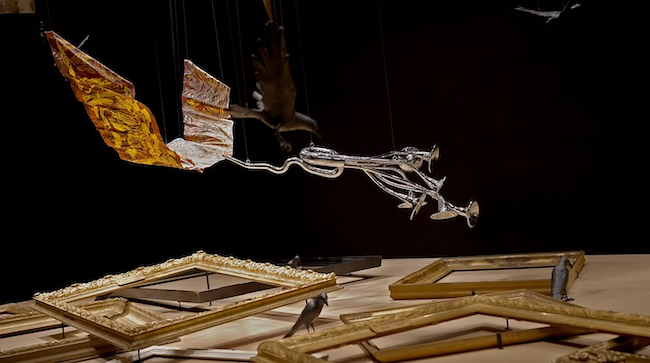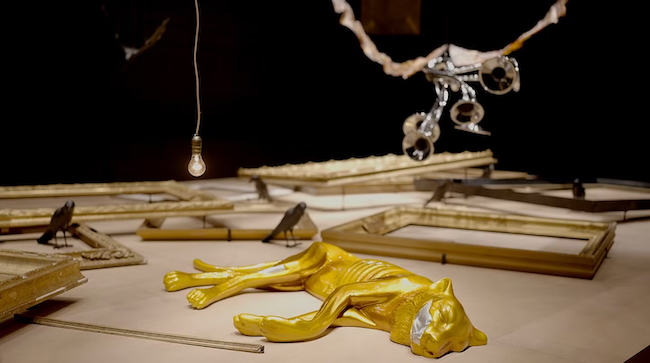When an artist applies a critical lens to museum collections, colonial objects are framed in new ways
Timoteus Anggawan Kusno
Versi Bh Indonesia
In spring 2019, while completing my Asia Culture Center-Rijksakademie residency, I met Harm Stevens, historian and curator at the Rijksmuseum Amsterdam. We discussed the significant role of colonial artifacts in Dutch institutions. Stevens shared fascinating insights from his extensive research on war trophies from the Indonesian archipelago. He also talked about his ongoing curatorial project, ‘Revolusi!’, which aimed to showcase diverse perspectives and voices from the Indonesian struggle to defend independence. The exhibition was being carefully designed within a framework of multivocality, presenting a compelling collection of objects and art from the pivotal period of 1945-1949.
My response to the project was that to comprehend the significance of the revolution, it was crucial to delve deeply into the centuries of colonial oppression, trauma and anti-colonial resistance that led to it. This required diving beneath the iceberg and exploring the revolution’s underlying causes. The revolution did not occur out of the blue, but was instead the outcome of a long and intricate history of subjugation and resistance. Curiously, many artifacts related to these anti-colonial struggles continue to be housed in Dutch cultural institutions, including the Rijksmuseum. This conversation led to my later collaboration with the Rijksmuseum as part of the Revolusi! exhibition.
A few days after our meeting at the Rijksmuseum cafeteria, we discussed the interconnectedness of the display and interpretation of these items with wider socio-political issues and historical power dynamics, as well as emerging decolonial debates. I emphasised the significance of integrating historical research, artistic exploration, intervention, and critical viewpoints into museums to reshape their role and apply a decolonial framework.
Inside the Rijksmuseum’s depot
We talked about the foundational knowledge that is applied to colonial objects and the need to reevaluate and reimagine these objects. We arranged a trip to see the Rijksmuseum’s storage located about one hour from Amsterdam. I was struck by the immense volume of objects from the Indonesian archipelago carefully contained there, but as I viewed these artifacts my feelings were conflicted. On the one hand, they represented a valuable resource for study and knowledge, but on the other, they seemed to have been stripped of their original cultural context due to the ‘scientific’ approach used in managing and ‘preserving’ them. While examining the tags, categories, tables and their accompanying system information, I recalled similarities to medical records in terms of the sterile and bureaucratic nature, and the complex procedures for handling the objects. Paradoxically, some of the objects contained incomplete or inaccurate data. After my initial visit, lingering questions remained, and the experience left a lasting impression.

Later that year, when I returned to Yogyakarta, I received an official invitation from the Rijksmuseum to conduct fieldwork at their storage facility in early 2020. This allowed me to undertake more extensive observations, select objects, and finalise my work plan once I was officially invited to contribute to the Revolusi! Exhibition.
Remaking the meanings of colonial, and colonially looted, objects
Exploring the collection up close, I witnessed the meticulous and attentive care with which each item was treated. In the Rijksmuseum depot, I came across various flags originating from the Indonesian archipelago. Many of these were acquired during the Dutch colonial military campaigns. As I unfurled them, I felt these flags embody a sense of unyielding spirit and anti-colonial resistance. The museum had very limited information about their origins and significance and ironically, some flags had been damaged due to preservation attempts decades ago. This discovery highlighted the challenges faced in preserving such artifacts.
Another artifact that captivated me was the gold framed portrait paintings of Dutch governor-generals. These grand portraits were once hung in the governor-general’s palace in Batavia to represent the continuity of colonial regime in the East Indies from 1840 to the end of Dutch colonial rule in 1942. Viewing them in person raised many questions.
When Japan invaded in March 1942, Governor-General Van Starkenborgh Stachouwer ordered their removal. They were hastily packed and sent to a sugar factory in East Java, only to be found and returned to Batavia by the Japanese. These portrait paintings were some of the first objects shipped to the Netherlands after the Dutch surrender in 1949. The fact that these paintings exist and are preserved provides insight into the power dynamics of colonialism and the long-lasting effects of Dutch rule in Indonesia.

These portraits of the governors-general, which served as a monument to colonial continuity, were still stored in the depot more than half a century later. The frames of most of the paintings displayed both the name of the governor-general and the artist. This Western tradition of framing is closely linked to the concepts of authorship and authority. If they were retrieved from the depot and displayed in the museum, this could be interpreted as a modernist gesture of glorifying the colonial power.
To challenge this narratology, for the exhibition I suggested removing the frames and scattering the paintings on the ground instead of displaying them conventionally on the walls. The curators agreed to consider it, even though it was an unexplored approach. The portraits had in fact never been exhibited outside the museum depot. Due to concerns about the condition of the paintings raised during the planning phase, the exhibition plan was modified. Instead of displaying the frameless portraits, I suggested exhibiting only the 'painting-less' frames, scattered on the floor like a deserted graveyard. This was a compromise that still preserved my artistic statement and the ideological stance of the work.
Capturing the spirit of the revolution
On another visit to Amsterdam, I joined the curatorial team at the Rijksmuseum to explore the national archive collection in The Hague. The collection comprised personal belongings and amulets of Indonesian freedom fighters seized during the revolution by NEFIS (The Netherlands East Indies Forces Intelligence Service), a Dutch intelligence and special operations unit that operated during World War II in the Japanese-occupied Netherlands East Indies.
Many of the talismans in the special collection were adorned with holy verses. I was reminded of similar objects called ‘jimat’, amulets inscribed in Arabic and crafted by traditional Qu’ranic scholars for their followers. Friends used to wear them in my kampong in Bengkulu Province, Sumatra. This encounter reminded me of the many flags and amulets I had seen in the depot, some of which contained verses from the Holy Qu’ran. This sparked my interest in exploring the connection between these objects and the anti-colonial spirit. Later I created recordings of the recitation of these scriptures to produce an immersive sonic experience to resurrect the silenced anti-colonial spirit embodied in these artifacts.
Decoloniality and personal reflection
As I further explored the historical artifacts in the Rijksmuseum, I questioned my connection to Indonesia’s colonial past. The diverse origins of these objects from across the archipelago heightened my awareness of Indonesia’s complex cultural identity and of its shared history with the Netherlands.
As a Javanese-raised Indonesian, I struggled with the lingering influence of Javanese-centrism, a legacy of colonialism that has persisted beyond independence. I was particularly curious about how colonialism was perceived before the concept of Indonesia took shape. As I worked on designing the installation with these objects, I pondered the ideas and beliefs that had driven people to make such profound sacrifices and resist submission even before the notion of a nation-state or nationalism had fully crystallised.

The creation of my installation Luka dan Bisa Kubawa Berlari involved a deep dive into the objects, and a search for hidden meanings. Working with colonial artifacts in museums forced me to consider how these objects are documented and presented, which in turn highlighted the power imbalances and silenced stories underpinning museums. My artistic process aimed to make the invisible visible and to expose historical injustices.
Additionally, I actively sought to disrupt the meaning of colonial objects and to remove their established symbolism. In this exhibition, I aimed to strip the governor-general portraits of their significance, challenging the colonial regime's assertion of unchallenged rule and continuity.
These approaches aim to decentralise historical narratives, demystify institutional power, and provide a space for historical reflection. The installation is just the beginning of broader discussions about colonial remnants in both cultural institutions and in knowledge production.
Timoteus Anggawan Kusno (t.a.kusno@uva.nl) is an artist, filmmaker and PhD Candidate at the University of Amsterdam. His work Luka dan Bisa Kubawa Berlari was featured in the Revolusi! exhibition at the Rijksmuseum, Amsterdam, 11 February-6 June 2022. For more about his work visit here.











